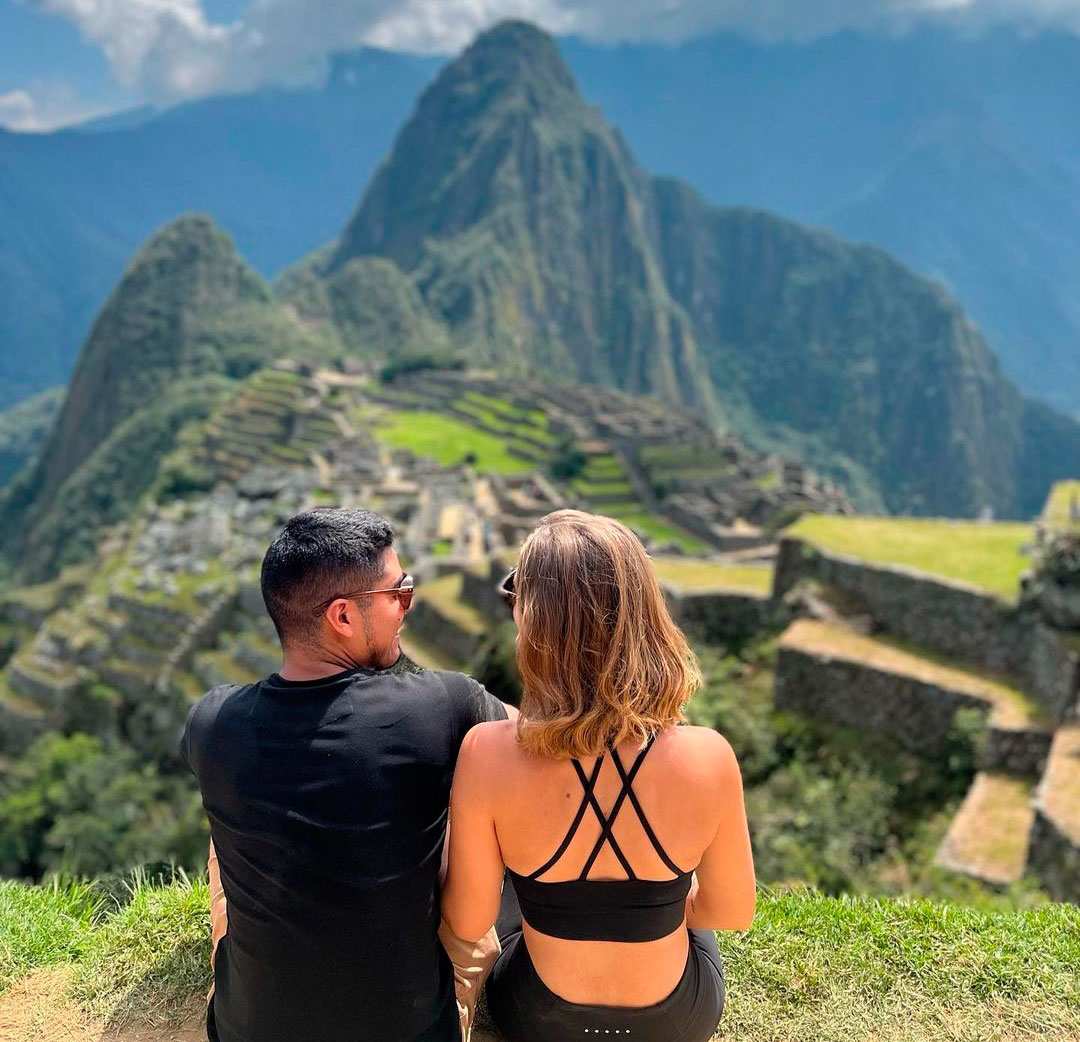Machu Picchu is one of the world’s new seven wonders. The mysterious Inca city of Machupicchu attracts and captivates millions of people from all around the world every year. The Inca religious sanctuary sits in the midst of the Andean mountains right above the river valley of Urubamba, surrounded by tropical cloud forest vegetation. Machupicchu stone Inca town lies at an altitude of 2400 meters in the eyebrow of the jungle.
Machu Picchu to Close 2024
Seasonal Closures at Machu Picchu: What Travelers Should Know
Machu Picchu, the iconic Inca citadel in Peru, stands as a must-visit destination for travelers worldwide. For those planning their journey, the prospect of Machu Picchu being closed is a common concern. While there are various reasons that may lead to temporary closures, the significance of this historical marvel ensures its continual operation as a top tourist attraction.
So, why might Machu Picchu close? Here are a few factors to consider:
1. Protests and Strikes
One of the primary reasons revolves around protests against government policies, especially concerning potential privatization attempts on these wonders of the world. The local population, including the residents of Machu Picchu and Cusco, vehemently opposes such privatization efforts. A recent protest in January 2024 emerged when the Minister of Culture proposed outsourcing ticket management.
2. Natural Disasters
Natural disasters, particularly during the rainy season from January to February, pose a risk. These disasters may result in railway line collapses or road obstructions along the Ollantaytambo-Machu Picchu route. In response, train services are temporarily suspended, and alternative transfers are provided during repairs. For routes like Cusco-Santa Maria, Santa Teresa, and Hidroelectrica (Amazonian Route), closures can be more severe, lasting several days at collapsed points, making travel during the dry season highly recommended.
3. Epidemics or Pandemics
The recent global pandemic, COVID-19, led to a two-year closure of Machu Picchu. Beginning on March 20, 2020, the site remained closed until its cautious reopening on July 20, 2021.
While closures are possible, Machu Picchu's enduring allure and importance make it a captivating destination worth exploring. Stay informed and plan your visit accordingly, considering the seasonal dynamics and potential external factors that may impact your experience at this enchanting Inca citadel.
Machu Picchu in February
Is Machu Picchu closed in February?
Curious if Machu Picchu is closed in February? No need to worry! Machu Picchu remains open year-round, including February. Whether you're planning a visit during the dry season or the rainy season, this iconic Inca citadel welcomes travelers throughout the year. Plan your adventure to this breathtaking wonder without concerns about closures in February.
Inca Trail Closure in February: Understanding the Reasons and Benefits
Every February, the renowned Inca Trail temporarily closes its doors in consideration of the prevailing conditions during the rainy season. This annual closure, implemented since 2002, is crucial for several reasons.
Rainy Season Challenges:
February marks the rainy season, bringing the risk of landslides comprised of earth and stones along the trail. These natural occurrences pose potential dangers, making the route hazardous for trekkers. Recognizing the safety concerns, the Machu Picchu Management Unit (UGM) initiated a comprehensive closure of Inca Trail routes. This strategic decision prioritizes visitor safety and has been in effect for years.
Maintenance Efforts:
While the trail is closed, Sernanp (National Service of Natural Areas Protected by the State) collaborates with tour operating agencies to execute thorough cleaning and maintenance procedures along the entire Inca Trail. This proactive approach ensures that the route is in optimal condition when it reopens, offering a safer and more enjoyable experience for trekkers.
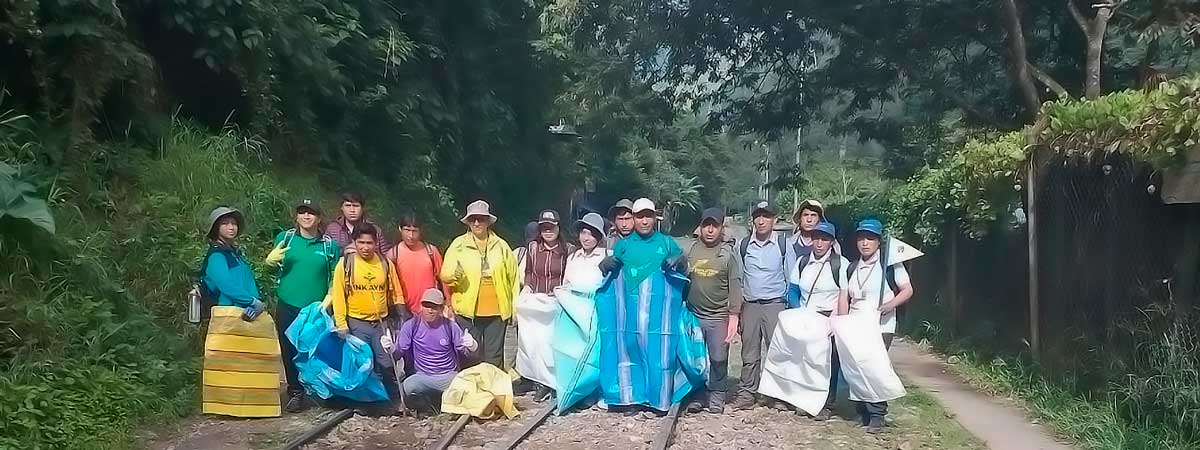
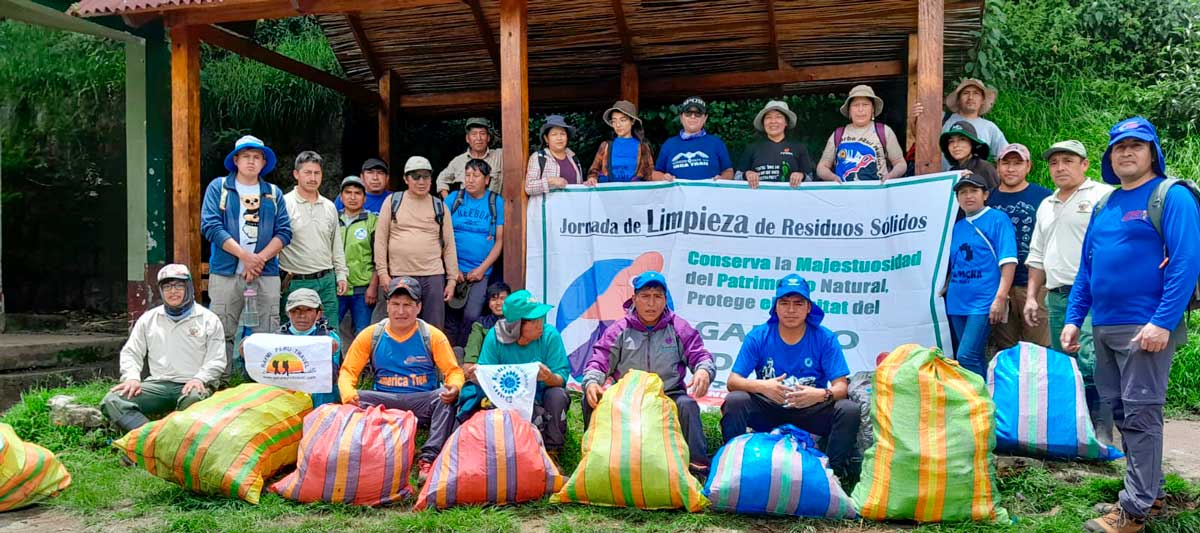
Getting Around
Bus Travel
Unless you hike the Inca Trail, you must first catch a train to Aguas Calientes. There is an official Consettur tourist bus that takes you to the famed ruins. If you are a day-tripper, follow the crowd out of the railway station about two blocks to the Consettur Machu Picchu shuttle buses, which take you up through a series of switchbacks to the ruins, a journey of 20 minutes. Before boarding, buy a USD14 round-trip (USD7 for children) ticket at the stand opposite of a number of buses. Bus tickets could be purchased in US dollars or Peruvian soles. If you are staying overnight, check in to your lodging first and then come back to buy a bus ticket. Buses leave Aguas Calientes towards the ruins apart of 5:30 AM and then depart approximately every 10 minutes. The biggest crowds appear in the mid-morning since trains arrive. The historic site closes at around 5:30 PM. If you head back to Cusco, take a shuttle bus back down at least an hour before your train departure. It is also possible to walk to and from the ruins to Aguas Calientes, but this hike takes you a good hour and a half either way (the way up is steep).
Train Travel
It is an easy ride from the railway stations of Cusco/Ollantaytambo to Machu Picchu. Most visitors board the train in Cusco. PeruRail is the oldest standing operator and it offers services from Ollantaytambo and Aguas Calientes too. Their train services include Vistadome, Expedition, and the luxury Hiram Bingham. Trains leave from the station Cusco - Poroy, a 15-minute taxi ride from Cusco's main square 'Plaza de Armas'. The newer operators of Inca Rail and Andean Railways offer services only between Ollantaytambo and Aguas Calientes; both of them are expected to extend services.
Day Tripping Vs Overnight
One can visit Machu Picchu on a day trip, but we recommend staying overnight at a hotel near its entrance or in Aguas Calientes. A day trip allows you about four hours at Machu Picchu. If you stay overnight, it enables you either visiting Machu Picchu after most tourists are gone or in the morning before they arrive.
Buying a Ticket
If you arrive without an admission ticket, you must purchase one in Aguas Calientes at the Instituto Nacional de Cultura (address: Avenida Pachacutec s/n, phone number: 084-211196). There is no ticket booth at the ruins' entrance. If you come with a tour, tickets are most likely taken care of for you. Buy your ticket the night before if you want to get in the historic sanctuary right away (shuttle bus service begins at 5:30 AM). From the time you purchase the ticket, you have three days to enter the Inca city. However, once you enter the citadel, the ticket is only valid for that day. So, if you arrive in the afternoon and visit the ruins and then you stay overnight with the intension of returning to the citadel the next morning, you will have to buy two tickets (one for every day).
Health and Safety
Machu Picchu and the Inca Trail are a breath-catching 300-700 meters (980-2,300 feet) lower than Cusco. But to be on the safe side about altitude effects, locally known as soroche, get an ample intake of liquids and eliminate or minimize alcohol and caffeine consumption. Smoking aggravates the problem. Some hotels have an oxygen supply for their guests' use. The medication acetazolamide can help offset the alkalosis caused by low oxygen at high elevations. Tap water is not safe to drink. Stick with the bottled variety, either 'con gas' (carbonated) or 'sin gas' (still). The San Luis brand of water is available almost everywhere.
The Short Inca Trail
Some Cusco's tour operators market a two-day, one night visiting Machu Picchu excursion as the Sacred Inca Trail or Royal Inca Trail. It is easier to procure reservations for these trips, but advance booking with a licensed tour operator is still essential. The excursion begins at the so-called Km 104, a stop on the Cusco-Machu Picchu rails. All of the hiking happens on the first day. Then, a hiker spends the night at a hotel in Aguas Calientes. The second day is dedicated to the visit of the ruins.
Hiking Tours to Machu Picchu
There are many routes leading to Machu Picchu. But none is like the Inca Trail Tours, the most famous pedestrian path in the Americas. After flying from the capital of Perú, Lima, you can arrive in Cusco to walk for four days along a path through forests and dense fog, millenary stone steps discovering several ruins of ancient fortifications and Inca cities while enjoying majestic views all the way.
Hikes to Machu Picchu are the following:
- Salkantay Trek to Machu Picchu 5 days
- Hiking the Inca Trail to Machu Picchu 5 days
- Inca Quarry Trail 4 Days
- 2 Day Inca Trail Tour
- 2 Day Inca Trail with Camping
- 3 Day Inca Trail
- Vilcabamba Hike to Machu Picchu 6 days
- Choquequirao Trek to Machu Picchu 9 days
- Ausangate Trek 7 days
Chronicles of Machu Picchu: Instances When the Iconic Wonder Temporarily Closed
Machu Picchu to Close: Protests and Strikes
Machu Picchu Faces Controversy as Ticketing System Undergoes Privatization
26/01/2024
Machu Picchu recently experienced another closure, affecting the residents of Aguas Calientes. The reason behind this closure is the privatization of ticket sales for Machu Picchu. On December 23rd, the Ministry of Culture announced that the previous booking system, www.machupicchu.gob.pe, would no longer sell tickets. Instead, a new system introduced by Joinnus and accessible through www.tuboletocultura.pe would handle ticket sales. Joinnus will charge a 3.5% commission per ticket for utilizing its booking system.
The local community in Aguas Calientes expressed dissatisfaction with this change, advocating for a return to the old booking system. Privatization has historically been met with skepticism in Peru, especially considering previous instances, such as the privatization of the train service to Machu Picchu. This move resulted in higher ticket prices, making it the most expensive train service in South America. The local population, including those in Cusco, resisted this change, anticipating that the privatization of Machu Picchu ticket sales might follow a similar trajectory.
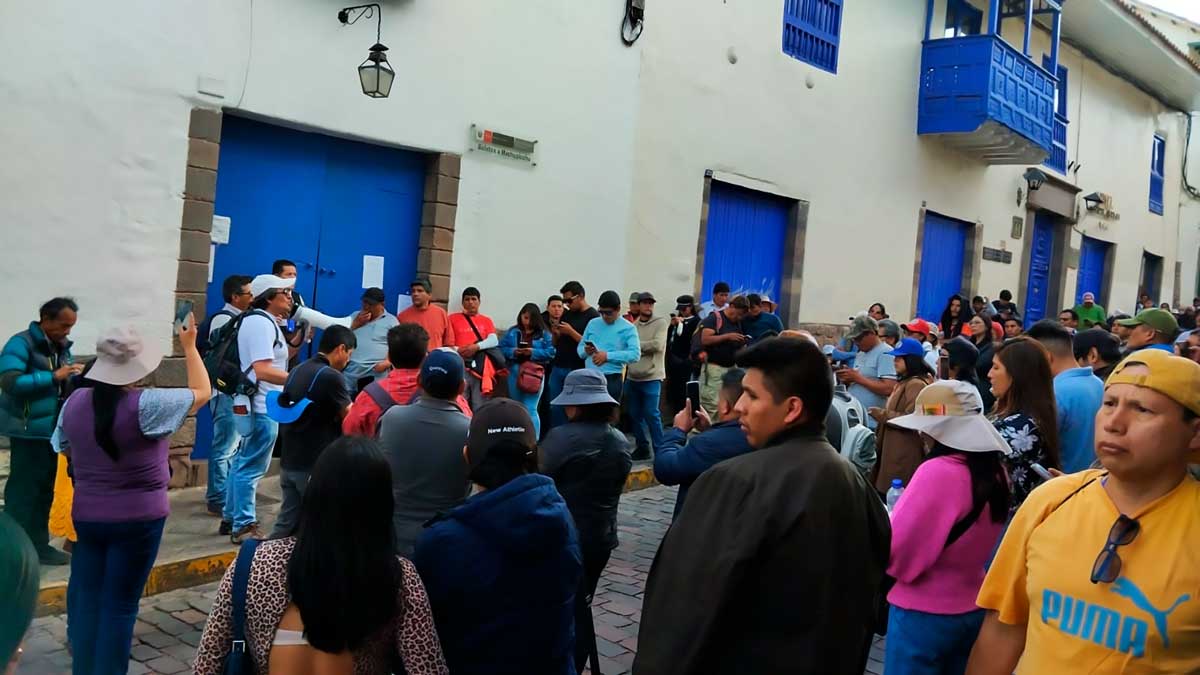
One concern is that the privatized system could lead to higher prices and limited discounts, as seen in the case of Perurail, the current train service provider. Perurail tends to offer discounts primarily to its customers during the low season, making it challenging for local operators to compete. The worry is that exclusive promotions and discounts by the privatized system may impact the accessibility of Machu Picchu for visitors and locals alike, as local agencies may struggle to match these offerings.
Machu Picchu to Close: Natural Disasters
Train Operations to Machu Picchu Halted Following Rain-Triggered Avalanches
26/02/2024
Machu Picchu - The company overseeing train services to the iconic Inca citadel of Machu Picchu has declared a two-day suspension in operations due to avalanches caused by recent rainfall. The incidents over the weekend have left two individuals missing and 17 others injured.
In an official statement, Ferrocarril Trasandino announced that rehabilitation of the railway, affected by "stone and earth slides," is estimated to take two days. Director Miguel Oscco from the Risk Management office in the Cusco region reported the missing individuals—a 54-year-old man and a 12-year-old teenager. The affected area serves as a transit route from Machu Picchu to a hydroelectric plant.
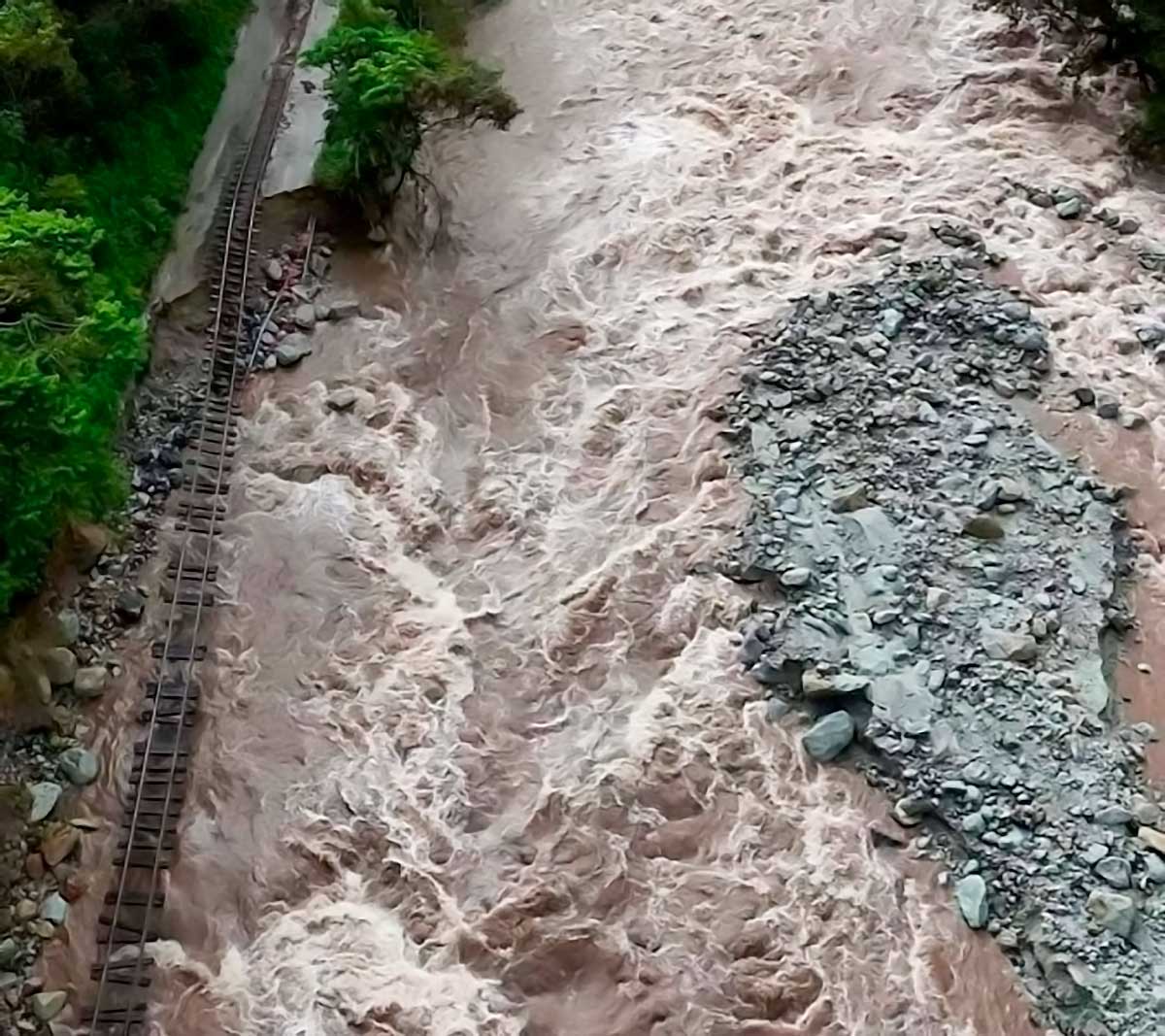
Following the avalanche, 17 individuals sustained injuries, receiving treatment at a nearby health center. The train, covering a 70-kilometer distance from Cusco to Machu Picchu, has temporarily ceased operations.
Machu Picchu's rainy season, a period from December to April, is known for increased risks, while the dry season spans from May to November. The Inca citadel, built in the 15th century as a religious sanctuary, resides in the Amazon region of southeastern Peru at an altitude of 2,490 meters.
Machu Picchu to Close: Epidemics or Pandemics
Machu Picchu reopens
Update: January 12, 2023
After days of protests and airport closures, Machu Picchu has reopened, dont forget to make your bookings in advance so as to secure your spots
What other archaeological parks are opening?
In addition to Machu Picchu, other archaeological sites in Cusco area are also resuming their activities. Tourists can also visit the following sites: Saqsaywaman, Q’enqo, Puka Pukara, Tambomachay, Pisaq, Chinchero, Ollantaytambo, Moray, Tipón and Pikillaqta.
Machu Picchu closed
Update January 21, 2023
The world heritage site of Machu Picchu, which is highly visited by tourists from all over the world, because of its historic and cultural importance among many other Andean cultures, it has been closed due to the current political situation in the country. The Peruvian Ministry of Culture announced on Saturday in Lima that the imminent close of the Machupicchu Inca site had been ordered: “because of the social situation and in order to ensure the safety of the visitors”.
When will Machu Picchu reopen?
The Inca Trail and Machu Picchu will reopen on March 1st, 2023, we highly recommend that you book and purchase your Inca trail permits beforehand.
Machu Picchu Official Statement
“Cusco Ministry of Culture agency and the Headquarters of the Historic Sanctuary of Machu Picchu of the National Service of Natural Areas Protected by the State (Sernanp) communicate that due to the current social situation in our region and the rest of the country, the closure of the Inka Road Network and the City of Machu Picchu has been ordered, from January 21, 2023, until further notice so as to protect the safety of tourists and the local population.
Likewise, all facilities will be provided to national and foreign tourists who will not be using the entrance tickets from January 21, 2023, until one month after the conclusion of the social mobilizations or request the return of the amount of the ticket”
Any further information please contact the email: info@tierrasvivas.com
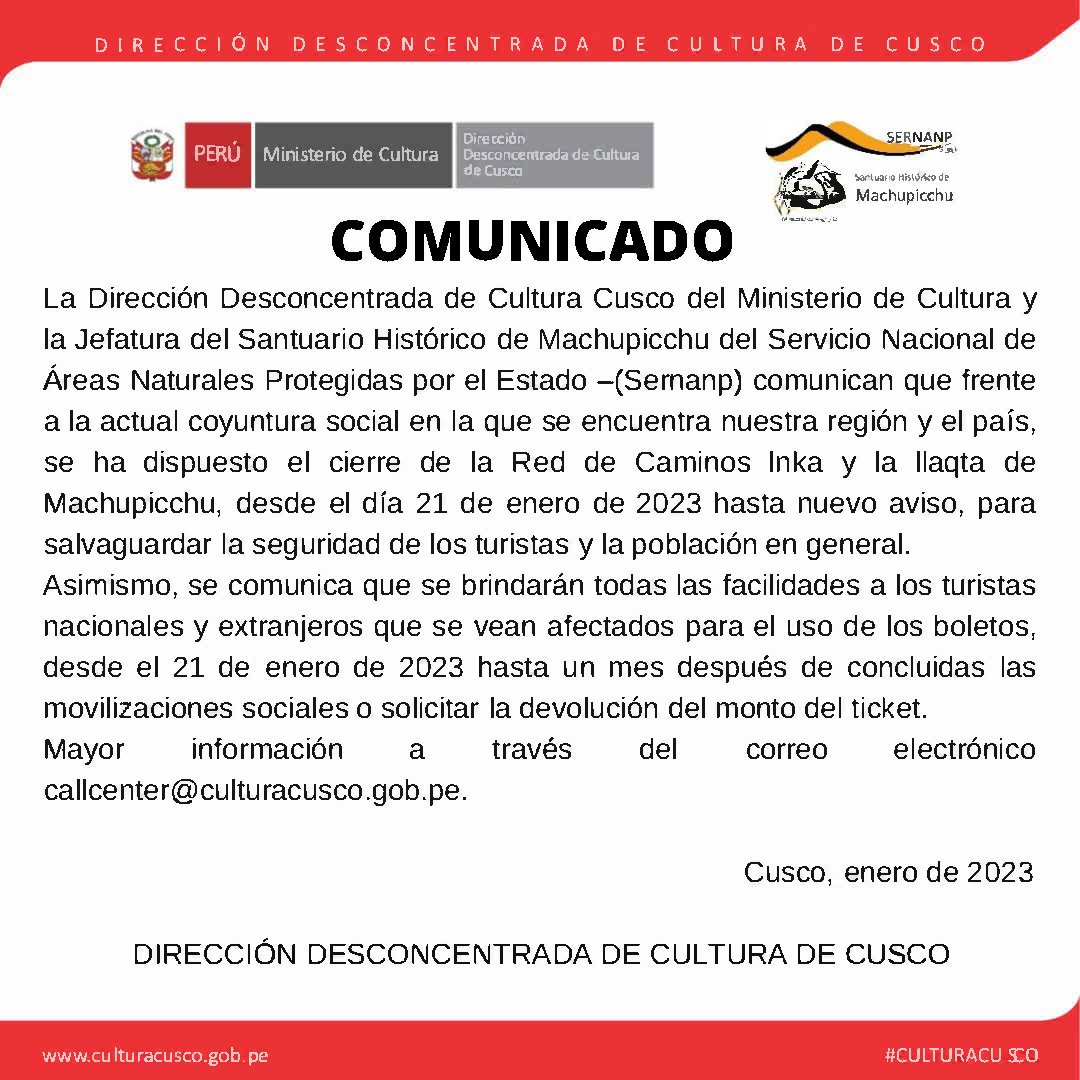
The closing of Machu Picchu
Update March 2020
Many tourists were wondering: Is Machu Picchu open? The answer was 'no'. It was closed since the Peruvian government ordered nationwide quarantine to prevent the spread of the coronavirus. However, the tourism industry is in crisis and its recovery (according to estimates) was be slow. It was the first time of Machu Picchu closing due to the pandemic.
When is Machu Picchu and Inca Trail open?
In search of reactivating tourism, the Peruvian government declared that on 15 July 2020 is Machu Picchu open again, but only for Peruvians. The Inca citadel of Machu Picchu was be free for children and senior national travelers (60+ year old) from July 15th to December 31st of 2020 as part of the measures adopted to revive domestic tourism.
In the first week of October 2020, the Peruvian government has reopened the borders and foreign tourists were be able to start visiting Machu Picchu and all Peru!
When is reopen Machu Picchu?
The Peruvian government published that Machu Picchu and Short Inca Trail reopen on March 1 2021. But only the 40% of the total capacity will be available. We recommend to book in advance, if you want to visit Machu Picchu.
At the moment, the 4 day Inca Trail is not open, but maybe it will be on 24 June 2021. The Salkantay, Choquequirao, Lares, Inca Quarry, Inca Jungle and others alternative treks to Machu Picchu are available to hike.
Machu Picchu Before And After the Coronavirus
Before Coranavirus, Machu Pichu used to be visited by many tourist, it was reached by train or by foot through the Inca trail and other alternative treks
Despite the fact that Peru was the first country in Latin America to enact the general quarantine, when there was hardly a record of 71 cases, COVID-19 has continued to advance due to the breach of isolation in some areas of the country. Find the exact data here.
On March 16th 2020, the restriction of mobilization in Peru to avoid infection by Covid-19 includes Machu Picchu closing. All tours were temporarily canceled until 1 October 2020.
The official advice of the World Health Organization (WHO) is that there is no need to stop any travel plans. However, the borders have been temporarily closed in Peru while monitoring the coronavirus contagion curve.
Today, the town of Aguas Calientes or Machu Picchu Town, where hotels, hostels, and restaurants for tourists are situated, it is open for foreigners and Peruvians. You can visit the lost city of the Incas this 2021.
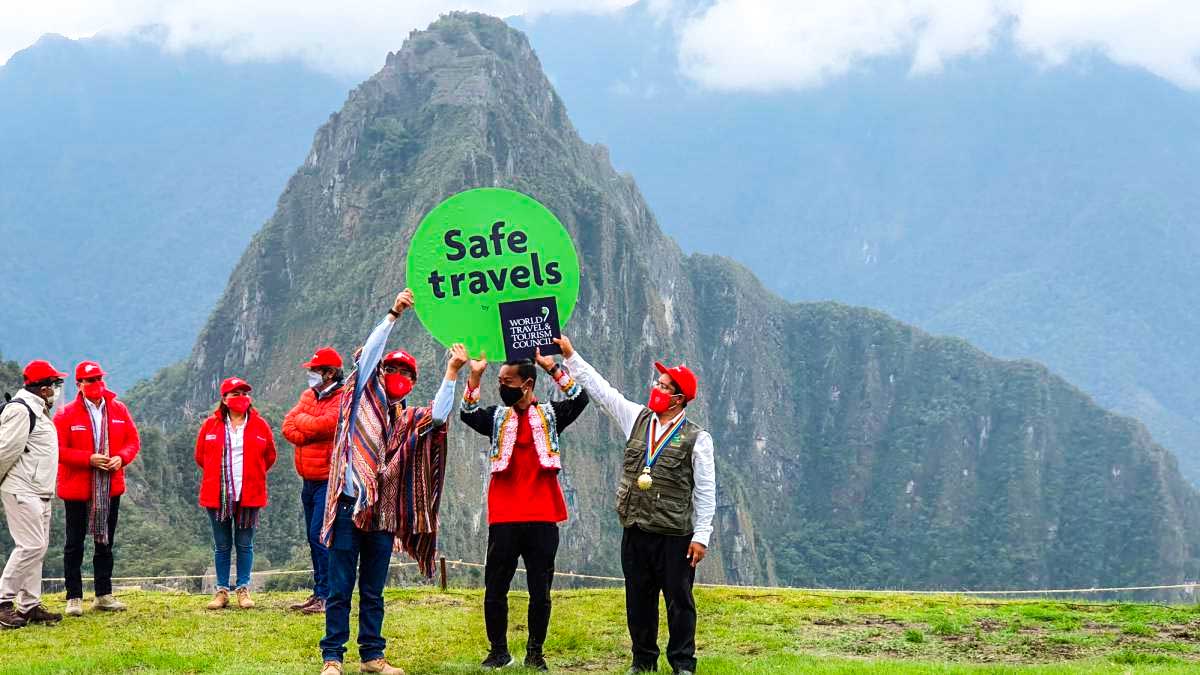
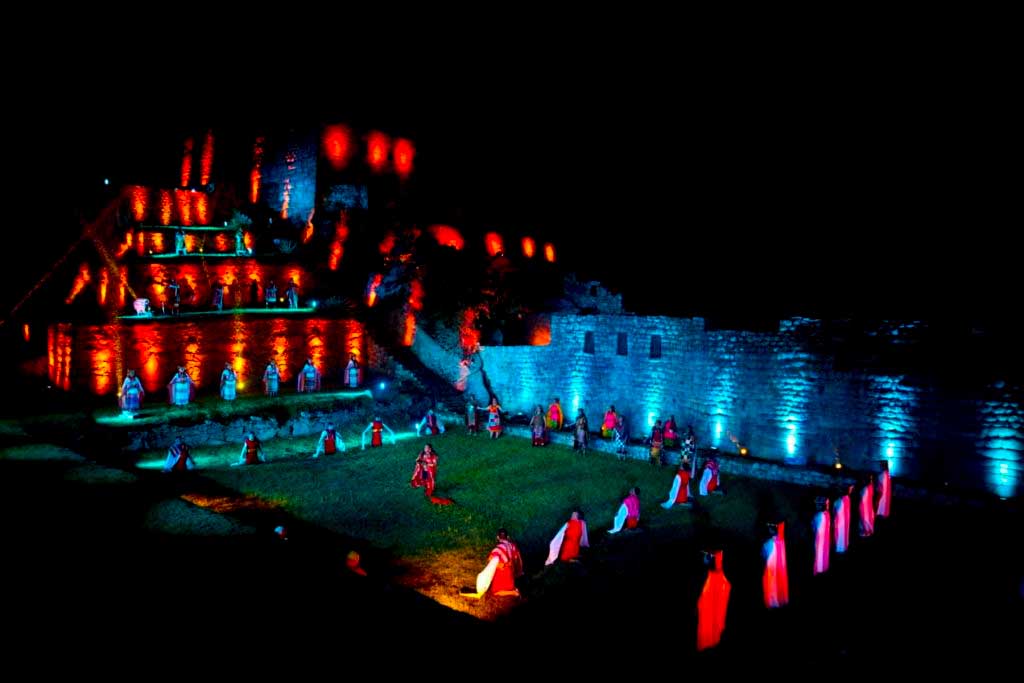
Also, the 2 Day Inca Trail was reopen. The Inca Trail was be free for minors and those over 60 until December 2020. So, you can enter the Inca Trail without tickets.
In the first week of January of 2021, the Inca Trail tickets have standardized their costs. However, it is very important to book in advance with a local tour operator. You cannot enter alone since this is prohibited! You will need to hire a local Tour Guide. But in case you want to do the 2 Day Inca Trail camping, you need a professional guide, Cook, and Porters.
In addition to Machu Picchu, the main tourist attraction of Peru, tourists will also be able to visit 54 other cultural sites and 22 protected natural reserves for free from July 1 to December 31 2020. For this year 2021, you will need to pay the ticket, if you want to visit.
The list of all tourist attractions published in a decree on Monday, September 14 2020, includes places such as the Nazca Lines - the famous geoglyphs made 1,500 years ago by the Nazca Civilization. The glyphs of geometric and animal shapes can be seen in all their magnitude from the air only.
Other exceptional sites included in the list are: Caral - the oldest city of both Americas constructed 5,000 years ago, and the citadel of Kuelap - commonly known as "the Machu Picchu of the Northern Peru" built 1,500 years ago by the Chachapoyas, a civilization that dominated the northernmost Andes before the Incas.
Other Places with Free Entrance
- The Wari archaeological complex situated in the Ayacucho Region which once used to be the capital of the first great empire of South America that preceded that of the Incas.
- The same benefit of free entrance will apply to Chan Chan - the largest adobe city of the Americas and the former capital of the Chimú Empire (situated on the outskirts of the current Trujillo City). Further north, one can visit the legacy of the Moche and the Sipan Culture (in the Lambayeque Region).
- Last but not least, there can be seen near the Chiclayo City the Tucume Pyramids and the Royal Tombs of Sipan Museum where the tomb of the Lord of Sipán, the first great ruler of ancient Peru, is preserved. It might be compared to Tutankhamun for the lavishness of his burial at Huaca Rajada which is also included in the list.
New Protocols for Travel
To carry out the reopening of the main tourist attractions in the country, the government will issue more regulations in the next 30 days to regulate tourist visits in accordance with the protocols of the Ministry of Health.
The quarantine was remain in place until the 30th of September 2020, the time when the Government hopes that some of these measures, such as the reactivation of transport nationwide, can be relaxed which would also facilitate the gradual resumption of the tourism sector.
However, this step anticipated last week by the Minister of Foreign Trade and Tourism, Edgar Vásquez, is still under evaluation based on the control of the pandemic.
On January 04th 2021, the Peruvian government published law about the new quarantine for the all foreign travellers. The Peruvian government is requiring a 14-day quarantine in Lima for all visitors.
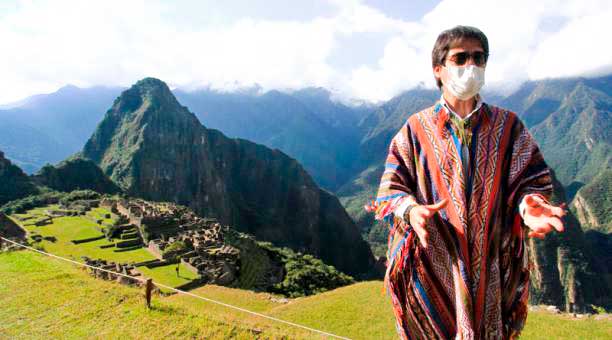
Public Concerns about Air Travel
Since the virus is NOT airborne and thanks to specialized aircraft ventilation designed to clean and ventilate the air, air travel should not be a cause for concern.
The virus can survive on surfaces for up to 30 minutes and you cannot contract the virus if you have not been in contact with someone who has it or someone who is a carrier.
The international and local flights are overflighting normally within and outside the country. With security protocols.
What tours can I do in Peru?
IIn this pandemic all tourist attractions were closed in Peru. For this year all tourist attractions are open, but there are new protocols for visiting. The all tour operator will need to reduce the traveller groups and they will have to add the new protocols of the Ministry of Health. You can book and visited the follow tourist attractions:
- Lima, Capital of Peru
- Machu Picchu, Cusco
- Inca Trail from Km 104 (2 Days/1Night), Cusco
- Ollantaytambo, Cusco
- Pisac, Cusco
- Chinchero, Cusco
- Inca Quarry Trail, Cusco
- Rainbow Mountain, Cusco
- Choquequirao, Cusco
- Vilcabamba, Cusco
- Kuelap, Amazonas
- Chachapayas, Amazonas
- Paracas, Ica
- Nazca Line, Ica
- Huacachina, Ica
- Colca Canyon, Arequipa
- Lake Titicaca, Puno
- Peruvian Rainforest, Puerto Maldonado and Iquitos
- Hiking in Huaraz
- Huayhuash mountain Trek, Huaraz
- All museums of Peru
There are tourist attraction are closed in this moment such as the 4 Day Inca Trail, Lares Trek, Salkantay Trek and Mancora Beaches.
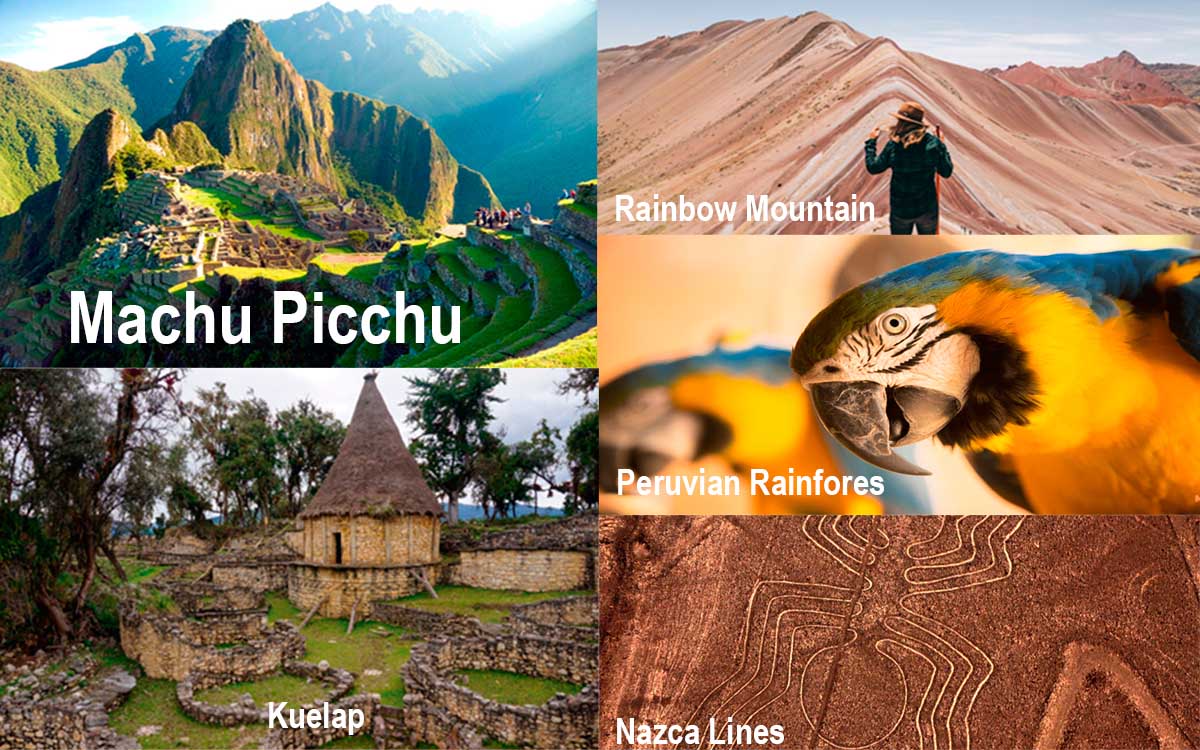
Machu Picchu Coronavirus
No worries, the Inca citadel is open and you can enjoy your vacation in Machu Picchu without any problem. We recommend you to not forget to buy your ticket in advance!
When to Visit Machu Picchu
All the high-season/low-season trades off. Winter in Peru is from June through August and it means drier weather and easier traveling. Also, this is prime vacation time for those from the northern hemisphere. Do not forget 3 major observances: Inti Raymi 2024 (June 24), Peru´s Independence Day (July 28), and Santa Rosa de Lima (August 30). All of them fall during this time and are transformed into exceptionally large crowds of Peruvian travelers. Prices and visitor numbers drop dramatically during the Peruvian summer rainy season - October through April. The same goes for the hike called Palcoyo Mountain Tour which takes you to the incredible Rainbow Mountain located in the Andes. Note that January is the peak of a rainy season and the Machu Picchu closing is in February. For almost ideal weather and manageable crowds, consider a spring or fall trip.
Personal Measure You Can Adopt
- Since the virus is transmitted through the drops, be sure to wash your hands well and follow the proper label when coughing and sneezing.
- The right thing is NOT to cough or sneeze without covering yourself with a tissue or elbow. You should discard your mouth cover immediately and wash your hands. If you sneeze or cough into your hand, you should also wash your hands immediately.
- You should also follow proper food hygiene precautions. Before cooking, you should wash your hands, wash vegetables, and utensils well before using them, and make sure that all your food is well cooked.
- The use of masks is very effective for people who are already affected by the disease. Unfortunately, for those who are not infected, the masks do not work to prevent the spread of the infection. However, you might use a respirator.
- Anyway, the official advice is to avoid nervous purchases of surgical supplies such as masks and to make them available to those who need them: people infected with the virus and people who care for them.
How to Wash Your Hands Correctly?
As you could see, the main recommendation is to wash your hands with soap and water for at least 2 minutes. The hands should be rubbed between the fingers and each finger separately, also the tips of the fingers against the palms to wash the inside of the nails. This infographic shows very well what is the correct technique to wash your hands.
What to Do If You Have Met Someone with the Coronavirus?
Wash your hands and monitor your health to detect any symptoms that may appear. If you feel really concerned, try to stay home for up to 2 weeks. If no symptoms develop by then, you are fine. If you start experiencing symptoms like fever and shortness of breath, seek medical attention.
What to Do If You Think You Have Been Infected with the Coronavirus?
If you experience symptoms of the Coronavirus, call the closest medical center. They should advise you about the best place to go to. Then, you should put on a mask to avoid infecting others and to go to the medical centre. Try not to cough near anyone and keep a minimum distance of 2 meters from other people.
85% of Coronavirus cases have mild symptoms and patients usually recover at home. There are people who are at higher risk such as the elderly or people with pre-existing respiratory problems.
If you are told that your symptoms are mild, but last more than 2 weeks, or if you have difficulty breathing, seek medical attention again.
What Measures Is Peru Taking to Reduce the Risk of the Coronavirus?
The Peruvian authorities have decided to take action for 15 days by restricting the mobility of people in the territory as well as closing the borders until the end of September. Food supplies and the movement of people who wish to return home have also been guaranteed. Supermarkets, pharmacies, health centers, and banks will remain open during these days and the mobilization of their workers is guaranteed.
The Peruvian government has also published the official budget and the implemented action plan to treat the virus:
- Public health promotion: a budget of PEN 129,360 is dedicated to the development and education of the public on the best way to avoid contracting or transmitting the virus.
- Disease Surveillance and Case Investigation: a budget of PEN 215,000 for staff training on case identification and monitoring.
- Laboratory support: a budget of PEN 174,200 to ensure the supply of materials necessary for diagnosis.
- Organization of health services: a huge budget of PEN 1,024,000 guarantees that there are spaces to handle the registered cases of the virus. (The budget includes isolation rooms and equipment for staff).
- Risk awareness and communication: a budget of PEN 1,529,040 is available.
- Protection of the environment for the health of workers: a budget is PEN 605,000.
- A mobile hospital has been installed at the airport of Lima to evaluate people at their arrival. It is expected that 9 more hospitals will be enabled if the risk of the virus increases.

